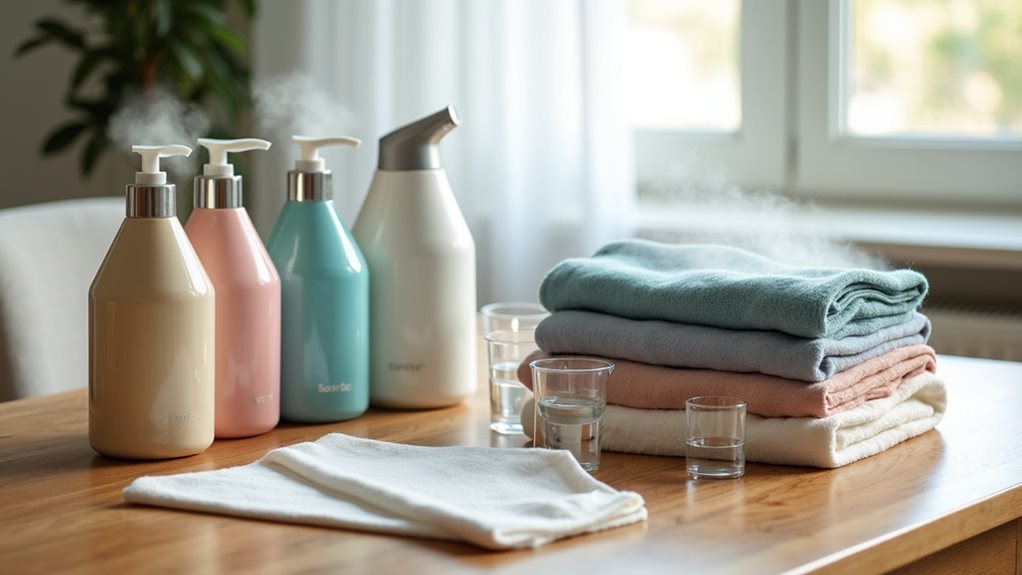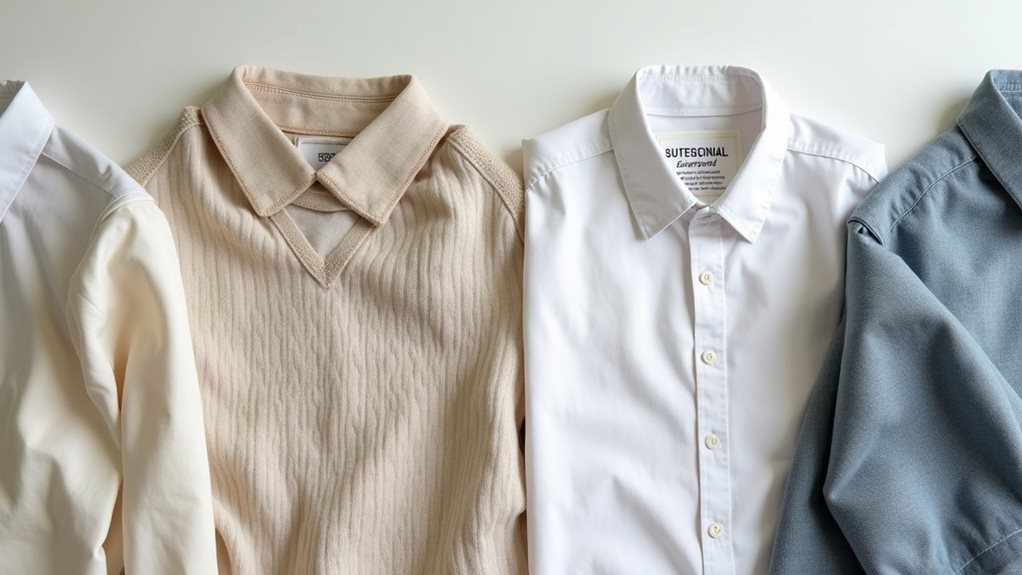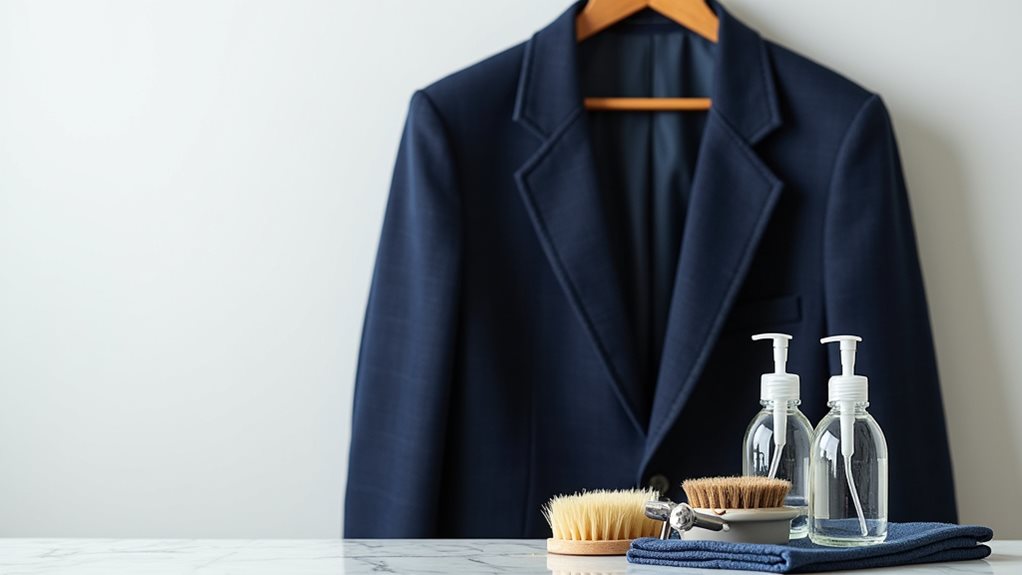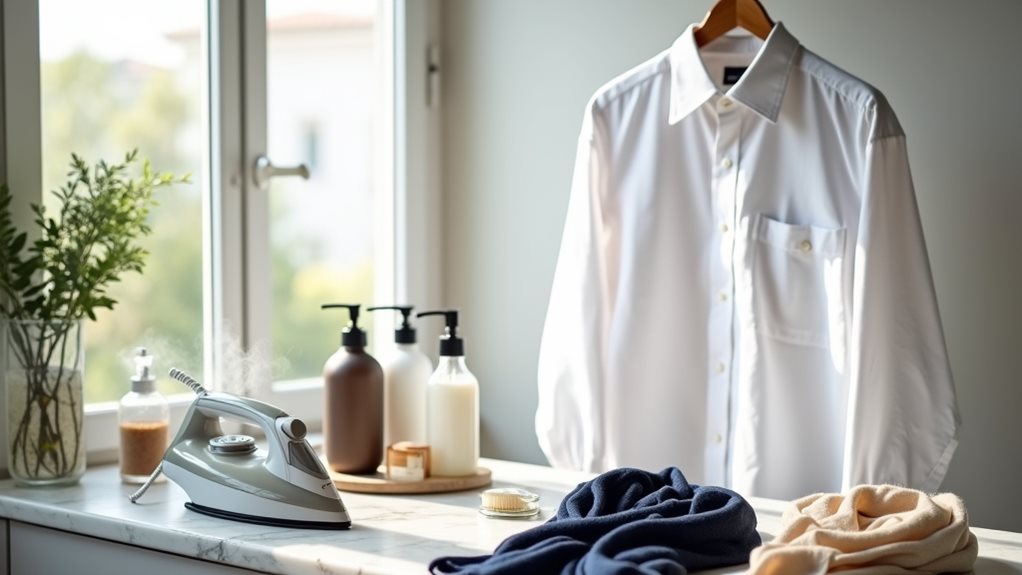You can definitely dry clean many garments at home using specialized kits like Dryel, which include dryer bags and stain removal pens that work surprisingly well for everyday “dry clean only” items. I’ve successfully freshened wool sweaters and silk blouses this way, though you’ll want to test on hidden areas first and verify proper ventilation when using solvents. However, precious pieces with beading, leather items, or heavily soiled garments still need professional expertise to avoid costly mistakes that could ruin your favorite pieces forever.
Why Some Clothes Require Dry Cleaning
The delicate dance between fabric and water became crystal clear to me the day I confidently tossed my favorite silk blouse into the washing machine, only to retrieve what looked like a sad, shrunken dollhouse version of its former self 😅.
This expensive lesson taught me why certain dry clean clothes demand special attention, particularly delicate fabrics like silk, wool, cashmere, and velvet that simply can’t handle water-based methods without suffering serious consequences.
When you see garments labeled “dry clean only,” it’s not merely a suggestion—it’s a protective warning.
These pieces, especially those with structured design like suits and formal wear, need solvent-based cleaning to prevent shrinking, color bleeding, and shape distortion that home cleaning methods can’t address.
The dry cleaning process is particularly effective at removing oil-based stains that water-based washing simply cannot tackle effectively.
Trust me, a professional dry cleaner’s expertise is worth every penny.
What You Need for Home Dry Cleaning

You’ll need to gather some vital cleaning supplies and set up your equipment properly before you can transform your home into a mini dry cleaning operation, and trust me, having everything ready beforehand will save you from that frustrating moment when you’re halfway through cleaning your favorite blazer only to realize you’re missing a key component.
Start with an at-home dry cleaning kit like Dryel, which includes those handy reusable dryer bags and stain removal pens that honestly work better than I expected when I first tried them on my husband’s coffee-stained tie.
You’ll also want to create a well-ventilated workspace, whether that’s your laundry room with the window cracked open or even outdoors if the weather cooperates, because proper airflow isn’t just recommended—it’s vital for your safety when working with cleaning solvents.
Before treating any garment, always test your chosen cleaning method on an inconspicuous area first to ensure the fabric won’t be damaged or discolored.
Essential Cleaning Supplies
Success in home dry cleaning starts with gathering the right arsenal of supplies, and trust me, I learned this lesson the hard way after ruining my favorite silk blouse with regular laundry detergent 😅.
You’ll need a mild detergent specifically formulated for delicate fabrics—home dry cleaning kits like Dryel work wonderfully here.
Set up your workspace with a clean sink for gentle hand washing, plus a soft cloth for spot cleaning those stubborn stains beforehand.
Don’t forget a garment bag to protect your clothes during the drying cycle.
Here’s where I get creative: white vinegar and baking soda become your secret weapons to absorb odors and freshen clothes naturally, transforming your laundry routine into something surprisingly effective and budget-friendly.
Consider investing in a handheld steamer for wrinkle removal and light cleaning, as steam cleaning can effectively refresh many delicate garments without harsh chemicals.
Required Equipment Setup
Now that you’ve got your cleaning supplies sorted, setting up your workspace properly can make the difference between professional-looking results and, well, the disaster I created when I tried dry cleaning my wool sweater in my cramped bathroom with zero ventilation 🤦♀️.
Here’s your crucial equipment checklist for transforming delicate fabrics without the hefty dry cleaning bills:
- Well-ventilated area – Trust me, proper airflow prevents that overwhelming chemical smell from lingering.
- Clean sink or basin – Perfect for gentle hand-washing when your dry cleaning kits need backup.
- Quality garment bag – Protects your precious clothing items during the steam cleaning process.
- Mild detergent – Specifically formulated for delicate materials, because regular detergent is way too harsh.
- Stain removers and steamer – Vital for pre-treating stains before the main event.
Most home dry cleaning kits include cleaning cloths that get activated by your dryer’s heat to release cleaning vapors throughout the fabric.
Step-by-Step Guide to Dry Cleaning at Home

Five essential steps can transform your intimidating pile of “dry clean only” garments into a manageable home project, and I’ll be honest—the first time I attempted this, I was convinced I’d ruin my favorite blazer 😅.
Start by checking each care label carefully, because trust me, you don’t want to learn this lesson the hard way.
Next, create a gentle cleaning solution using cool water and common household supplies like mild detergent, then soak your garments for twenty minutes to remove stains effectively.
Rinse thoroughly to avoid damage, then use your at-home dry cleaning kit with a garment bag for steam cleaning in the dryer.
Finally, hang or lay flat to dry completely—patience here prevents disasters when you dry clean your clothes.
Before attempting any home cleaning method, always test an inconspicuous area first to ensure the fabric can handle the cleaning process without damage.
How to Treat Stains Before Home Dry Cleaning

The moment you spot a mysterious stain on your favorite dress shirt, your heart might sink a little.
But I’ve learned that tackling these blemishes before attempting home dry cleaning can mean the difference between saving your garment and watching it become a very expensive cleaning rag 😬.
Trust me, I’ve turned perfectly good clothes into disasters by skipping this vital step, so let me share what actually works when you need to treat stains on delicate items.
Here’s my battle-tested approach for preparing stains before home dry cleaning:
- Always perform a spot test with any stain removers on hidden fabric areas first
- Mix white vinegar and water for stubborn oil-based stains
- Use gentle detergent with cold water for protein-based stains
- Try oxygen bleach for improved brightness on lighter fabrics
- Gently brush treatments in, then let them penetrate before proceeding
Remember that while home treatment can help with many stains, professional dry cleaning uses specialized chemical solvents that can tackle stubborn oil-based and protein-based stains more effectively than water-based cleaning methods.
Which Garments Can Be Safely Dry Cleaned at Home

After you’ve mastered the art of pre-treating those pesky stains, you’ll want to know which pieces in your wardrobe can actually handle the home dry cleaning treatment without turning into expensive mistakes.
Garments made from rayon, silk, wool, and cashmere respond beautifully to gentle methods with mild detergents, though you’ll need to check those “dry clean only” labels first – some fabric really does need professional cleaning to survive intact.
Jeans, blouses, trousers, and unstructured outerwear are typically suitable candidates for your DIY adventures, especially when dealing with light stains and everyday odors.
However, items with intricate beading or embellishments should always be left to professional dry cleaners who have the expertise and specialized equipment to handle these delicate details safely.
Before diving in, always perform a colorfastness test on a hidden seam because discovering your favorite shirt bleeds color halfway through dry cleaning at home is nobody’s idea of fun!
When Professional Dry Cleaning Is Still Necessary

While home dry cleaning can work wonders for many garments, some pieces in your closet deserve the royal treatment that only professional cleaners can provide.
Some garments are worth the investment in professional care—your wardrobe’s most precious pieces deserve expert handling.
Trust me, I learned this lesson the hard way when I tried to “refresh” my grandfather’s vintage leather jacket with a home kit.
Here’s when you should skip the DIY route and head straight to the pros:
- Delicate fabrics like leather, suede, and fur need specialized care that home kits simply can’t match.
- Structured garments such as suits with shoulder pads require professional techniques to maintain their shape.
- Antique clothing and heirloom pieces demand expert preservation methods to avoid irreversible damage.
- Items labeled “dry clean only” contain materials that won’t survive home cleaning adventures.
- Deep stains and heavy soiling from oil or grease need professional-grade treatment for complete removal.
Clothing with intricate details like beading, sequins, or pleating also requires professional dry cleaning to preserve these delicate embellishments and prevent damage that home cleaning methods might cause.




